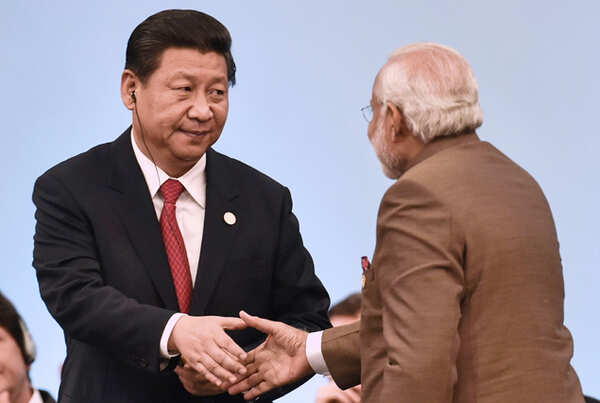- News
- City News
- ahmedabad News
- Gujarat to be crucial in Xi’s ‘Silk Route’ dream
Trending
This story is from September 14, 2014
Gujarat to be crucial in Xi’s ‘Silk Route’ dream
Even as the visit of Chinese President Xi Jinping promises to write a fresh chapter in Sino-Indian relationship, the start of his India sojourn from Gujarat could not be more symbolic.

AHMEDABAD: Even as the visit of Chinese President Xi Jinping promises to write a fresh chapter in Sino-Indian relationship, the start of his India sojourn from Gujarat could not be more symbolic. On the ancient ‘Silk Route', ports of Gujarat served as links between China and the markets in Europe and the Gulf bringing wealth to Gujarati as well as Chinese traders.
Reviving the ancient route is Xi’s dream and he is striving for it through his ‘New Chinese Silk Route Project’. China needs India — because of its ports and strategic geographical location — as an essential partner for the project.
READ ALSO: Heavy security blanket for Modi, Jinping visit to Gujarat
In this backdrop, Xi meeting Prime Minister Narendra Modi on Gujarati soil may prove crucial for getting India to collaborate in China’s efforts to revive the route. Moreover, India's cooperation is vital as the ultimate aim of the Chinese is to develop a trading network challenging those dominated by the US-led West.
The ‘spice islands’ of Southeast Asia, including today’s Thailand, Malaysia, Singapore and Indonesia, were important meeting points for Gujarati and Chinese traders from the seventh to the 14th century.

Chinese President Xi Jinping (left) with Prime Minister Narendra Modi.
Amdavadis benefited from opium trade
A development in the early 19th century became pivotal for this city. Due to British influence, a large population of China started consuming opium and there was sudden spike in demand for the narcotic for both medicinal and recreational purposes. Seizing this opportunity, entrepreneurs like Hutheesing Kesrising got opium from Malwa (now in Madhya Pradesh) and started exporting it to China through Ghogha and Bombay ports. Other notable businessmen who dealt directly with China from Ahmedabad include Nagarsheth Vakhatchand Khushalchand and his son, Himabhai, along with Karamchand Premchand, ancestors of the Sarabhai family.
Gujaratis had pedhi in China
Makrand Mehta mentions that ‘Mumbai no Bahar', a book written by Ratanji Faramji Vacha in 1872, gave an account of Gujarati traders from Bombay establishing trading firms (pedhi) in Chinese port cities such as Canton. The book describes the Chinese as industrious and hard-working but shy people.
Reviving the ancient route is Xi’s dream and he is striving for it through his ‘New Chinese Silk Route Project’. China needs India — because of its ports and strategic geographical location — as an essential partner for the project.
READ ALSO: Heavy security blanket for Modi, Jinping visit to Gujarat
In this backdrop, Xi meeting Prime Minister Narendra Modi on Gujarati soil may prove crucial for getting India to collaborate in China’s efforts to revive the route. Moreover, India's cooperation is vital as the ultimate aim of the Chinese is to develop a trading network challenging those dominated by the US-led West.
According to historians, the riches of Gujarati traders in ancient times came largely from the state’s strategic location on the Silk Route. Historian Makrand Mehta mentions in his book ‘Gujarat and the Sea', that Bharuch was one of the ports that benefited immensely after the Han Dynasty started the trade route in 306 BC.
The ‘spice islands’ of Southeast Asia, including today’s Thailand, Malaysia, Singapore and Indonesia, were important meeting points for Gujarati and Chinese traders from the seventh to the 14th century.

Chinese President Xi Jinping (left) with Prime Minister Narendra Modi.
Amdavadis benefited from opium trade
A development in the early 19th century became pivotal for this city. Due to British influence, a large population of China started consuming opium and there was sudden spike in demand for the narcotic for both medicinal and recreational purposes. Seizing this opportunity, entrepreneurs like Hutheesing Kesrising got opium from Malwa (now in Madhya Pradesh) and started exporting it to China through Ghogha and Bombay ports. Other notable businessmen who dealt directly with China from Ahmedabad include Nagarsheth Vakhatchand Khushalchand and his son, Himabhai, along with Karamchand Premchand, ancestors of the Sarabhai family.
Gujaratis had pedhi in China
Makrand Mehta mentions that ‘Mumbai no Bahar', a book written by Ratanji Faramji Vacha in 1872, gave an account of Gujarati traders from Bombay establishing trading firms (pedhi) in Chinese port cities such as Canton. The book describes the Chinese as industrious and hard-working but shy people.
End of Article
FOLLOW US ON SOCIAL MEDIA










